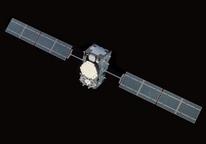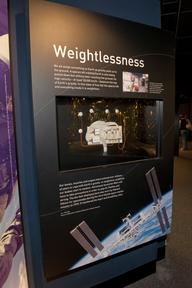

Exoplanet Satellite Telescope 'CHEOPS'
- Made:
- 2022 in Netherlands
- maker:
- European Space Agency and
- Hupkens Industrial Models
Model of the 'Characterising Exoplanet Satellite' or CHEOPS spacecraft, scale 1:1, made by ESA/Hupkens Industrial Models, 2022.
Orbiting the Earth, CHEOPS observes a variety of bright, nearby stars (the brightest barely visible to the naked eye) known to host exoplanets. Since the discovery of the first exoplanet in 1992, over 5000 exoplanets have been identified. Using detectors covering the visible wavelength and near-infrared spectrum, the satellite focuses on small planets, Earth to Neptune-sized with orbits of 50 days or less. Orbits of this length are more accurately measured as multiple transits can be observed over the course of the mission.
CHEOPS uses transit photometry to measure the fraction of light blocked from reaching the satellite by the exoplanet as it crosses in front of the star. This helps scientists to determine the planet’s size, shape, and mass, as well as ascertain if a planet has an atmosphere. Additionally, information on differences in planet temperatures and atmosphere composition (including potential clouds) comes from analysing the star light reflected off the exoplanet’s surface at different times in its transit (phase curves). The information will enable astronomers to refine models of planetary formation, potentially changing the understanding of how our own solar system evolved. CHEOPS has already identified a previously undetected exoplanet Nu2 Lupid and characterised a known exoplanet, WASP-103, revealing its rugby-ball shape.
The project is led by the Centre for Space and Habitability at the University of Bern, Switzerland, and is backed by 10 other ESA members (United Kingdom, Belgium, France, Portugal, Spain, Italy, Hungary, Austria, Germany, and Sweden) and Canada. It was the first Small-class mission of ESA’s Cosmic Vision campaign. This campaign develops ‘cheaper’ more affordable missions, which do not exceed 500 million euros. It is one of three exoplanet satellites, each tackling a different aspect of exoplanet science.
Details
- Category:
- Space Technology
- Object Number:
- 2022-1040
- Materials:
- steel (metal), aluminium (metal), plastic (unidentified), polyester, Dibond and 3-D printed parts
- Measurements:
-
overall: 1450 mm x 1630 mm x 1265 mm, 100 kg
crate: 1450 mm x 1700 mm x 2000 mm,
- type:
- telescope




